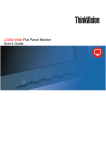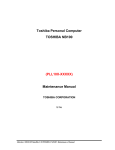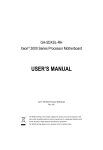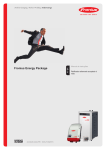Download Lenovo ThinkVision L2240p User's Manual
Transcript
L2240p Wide Flat Panel Monitor User’s Guide Product number 4422-H*6 First Edition (May 2008) © Copyright Lenovo 2008. All rights reserved. LENOVO products, data, computer software, and services have been developed exclusively at private expense and are asold to governmental entities as commercial items as defined by 48 C.F.R. 2.101 with limited and restricted rights to use, reproduction and disclosure. LIMITED AND RESTRICTED RIGHTS NOTICE: IF products, data, computer software, or services are delivered pursuant a General Services Administration "GSA" contract, use, reproduction, or disclosure is subject to restrictions set forth in Contract No. GS-35F-05925. Copyright Lenovo 2008. i Contents Safety information …………………………………………………………………… iii Safety and Maintenance Guidelines ………………...………………………………… iv Chapter 1. Getting started ……………………………….………………………… 1-1 Shipping contents ………………………………………………………………………………………..… 1-1 Product overview ………………………………………………………………………………………..… 1-2 Types of adjustments ……………………………………………………………………………………... 1-2 User controls ……………………………………………………………………………………………… 1-3 Cable lock slot ……………………………………………………………………………………………. 1-4 Setting up your monitor ……………………………………………………………………………………... 1-4 Connecting and turning on your monitor ………………………………………………………………… 1-4 Registering your option ……………………………………………………………………………………... 1-9 Chapter 2. Adusting and using your monitor …………………………………………..2-1 Comfort and accessibility …………………………………………………………………………………… 2-1 Arranging your work area ………………………………………………………………………………... 2-1 Quick tips for healthy work habits ……………………………………………………………………….. 2-2 Accessibility information ………………………………………………………………………………… 2-2 Adjusting your monitor image ……………………………………………………………………………… 2-3 Using the direct access controls ………………………………………………………………………….. 2-3 Using the On-Screen Display (OSD) controls …………………………………………………………… 2-3 Selecting a supported display mode ……………………………………………………………………….... 2-5 Understanding power management …………………………………………………………………………. 2-6 Caring for your monitor ………………………………………………………………………………………2-7 Detaching the monitor stand ………………………………………………………………………………… 2-7 Chapter 3. Reference information ………………………………………………..……..3-1 Monitor specifications ………………………………………………………………………………………..3-1 Troubleshooting ………………………………………………………………………………………………3-2 Manual Image setup ……………………………………………………………………………………….3-3 Manually installing the monitor driver …………………………………………………………………… 3-4 Service information ………………………………………………………………………………………..3-7 Appendix A. Service and Support …………………………………………..…………...A-1 Online technical support ………………………………………………………………………..……………. A-1 Telephone technical support ………………………………………………………………………..………... A-1 Worldwide telephone list …….…………………………………………………………………….……… A-1 Appendix B. Notices ………………………………………………………………….……B-1 Trademarks …………………………………………………………………………………………………… B-2 Copyright Lenovo 2008. ii 3AFETY INFORMATION ǰ ¢ ǯ ǰ ³ä ³ǯ Prije instaliranja ovog proizvoda obavezno pročitajte sigurnosne upute. 0REDINSTALAC¤TOHOTOPRODUKTUSIPRECTETEPR¤RUCKUBEZPECNOSTN¤CHINSTRUKC¤ ® Ğǰ è Ĵ ǯ Ĵ §§ Ĵǰ ¢ ǯ Ȃ ǰ £ ··ǯ ǯ Ĵǰ £ ££ǯ Ğǯ ǻ¢ Ǽ è Ĵ ǯ ǰ ³ä ³ǯ à ǯ Måt tålfsifutjogpsnbujpofo joobo ev jotubmmfsbs efo iås qspevlufo/ sUmGanBt’manli¥tl¥n; muneBlcab;epIþmbBa©ÚlkmμviFI Ț ¢ ŘŖŖ8. i ii Safety and Maintenance Guidelines Important Safety Information The power cord is designed for use with your monitor. To use a different cord, use only a power source and connection compatible with this monitor. WARNING: Always connect your monitor, the computer, and other equipment to a grounded (earthed) power outlet. To reduce the risk of electric shock or damage to your equipment, do not diable the power cord grounding feature. The grounding plug is an important safety feature. WARNING: For your safety, be sure that the grounded power outlet you plug the power cord into is easily accessible to the operator and located as close to the equipment as possible. To disconnect power from the equipment, unplug the power cord from the power outlet by grasping the plug firmly. Never pull on the cord. CAUTION: To protect your monitor, as well as your computer, connect all power cords for your computer and its peripheral devices (such as a monitor, printer, or scanner) to a surge protection device such as a power strip with surge protection or uninterruptible power supply (UPS). Not all power strips provide surge protection; the power strips must be specifically labeled as having this ability. Use a power strip whose manufacturer offers a damage replacement policy, so you can replace your equipment if surge protection fails. CAUTION: A certified power supply cord has to be used with this equipment. The relevant national installation and/or equipment regulations shall be considered. A certified power supply cord not lighter than ordinary polyvinyl chloride flexible cord according to IEC 60227 (designation H05VV-F 3G 0.75mm² or H05VVH2-F2 3G 0.75mm²) shall be used. Alternative a flexible cord be of synthetic rubber. Safety Precautions ■ ■ ■ ■ Use only a power source and connection compatible with this monitor, as indicated on the label/back plate of the monitor. Be sure the total ampere rating of the products connected to the outlet dose not exceed the current rating of the electrical outlet, and the total ampere rating of the products connected to the power cord does not exceed the rating of the power cord. Look on the power label to determine the ampere rating (Amps or A) for each device. Install your monitor near a power outlet that you can easily reach. Disconnect the monitor by grasping the plug firmly and pulling it from the outlet. Never disconnect the monitor by pulling the cord. Do not allow anything to rest on the power cord. Do not walk on the cord. Maintenance Guidelines To enhance the performance and extend the life of your monitor: ■ Do not open your monitor cabinet or attempt to service this product yourself. If your monitor is not operating properly or has been dropped or damaged, contact your Hewlett-Packard authorized dealer, reseller, or service provider. ■ Adjust only those controls that are described in the operating instructions. ■ Turn your monitor off when not in use. You can substantially increase the life expectancy of the monitor by using a screen saver program and turning off the monitor when not in use. ■ Keep your monitor in a well-ventilated area, away from excessive light, heat, or moisture. ■ Slots and openings in the cabinet are provided for ventilation. These openings must not be blocked or covered. Never push objects of any kind into cabinet slots or other openings. ■ Unplug the monitor from the power outlet before cleaning. Do not use liquid cleaners or aerosol cleaners. ■ Do not drop the monitor or place it on an unstable surface. ■ When removing the monitor base, you must lay the monitor face down on a soft area to prevent it from getting scratched, defaced, or broken. Cleaning the Monitor The monitor is a high-quality optical device that requires special care when cleaning. To clean the monitor, follow these steps: 1. Turn off the computer and the monitor. 2. Unplug your monitor from the power outlet before cleaning. CAUTION: Do not use benzene, thinner, ammonia, or any volatile substance to clean the monitor screen or cabinet. These chemicals may damage the monitor. Do not use liquid or aerosol cleaners. Never user water to clean an LCD screen. 3. 4. 5. 6. Wipe the screen with a dry, soft, clean cloth. If the screen requires additional cleaning, use an antistatic screen cleaner. Dust the monitor housing. Use a damp cloth to clean the cabinet. If the cabinet requires additional cleaning, use a clean cloth dampened with isopropyl alcohol. Plug in the monitor. Turn on the monitor and the computer. iv Chapter 1. Getting started This User’s Guide contains detailed information on the ThinkVision™ L2240p Wide Flat Panel Monitor. For a quick overview, please see the Setup Poster that was shipped with your monitor. Shipping contents The product package should include the following items: ● Setup Poster ● Monitor Safety, Troubleshooting, and Warranty Guide ● Reference and Driver CD ● Flat Panel Monitor ● Power Cord ● Analog Interface Cable- Attached to monitor ● Digital Interface Cable ● Cable Wrapper ● Cable Cover Note: To attach a VESA mount, please see “Detaching the monitor stand” on page 2-7. Copyright Lenovo 2008. 1-1 Product overview This section will provide information on adjusting monitor positions, setting user controls, and using the cable lock slot. Types of adjustments Tilt Please see the illustration below for an example of the tilt range. Swivel With the built-in pedestal, you can tilt and swivel the monitor for the most comfortable viewing angle. Height Adjustment After pressing the top of the monitor, remove the fixed pin and adjust the height of the monitor. 110mm 1-2 L2240p Wide Flat Panel Monitor User’s Guide Monitor Pivot - Adjust height to the top position before rotation the monitor. - Rotate clockwise until the monitor stops at 90°. User controls Your monitor has controls on the front which are used to adjust the display. For information on how to use these controls, please see “Adjusting your monitor image ” on page 2-3. Chapter 1. Getting started 1-3 Cable lock slot Your monitor is equipped with a cable lock slot located on the rear of your monitor (in the lower right corner). Please follow the instructions that came with the cable lock to attach it. Setting up your monitor This section provides information to help you set up your monitor. Connecting and turning on your monitor Note: Be sure to read the Safety Information located in the Monitor Safety, Troubleshooting, and Warranty Guide before carrying out this procedure. 1-4 1. Power off your computer and all attached devices, and unplug the computer power cord. 2. Connect the digital signal cable to the video port on the back of the computer. Note: One end of the signal cable is already pre-attached to your monitor. L2240p Wide Flat Panel Monitor User’s Guide 3. Connect the analog signal cable to the D-SUB connector of the monitor and the other end on the back of the computer. 4. Plug the monitor power cord and the computer cord into grounded electrical outlets. Note: A certified power supply cord has to be used with this equipment. The relevant national installation and/or equipment regulations shall be considered. A certified power supply cord not lighter than ordinary polyvinyl chloride flexible cord according to IEC 60227 (designation H05VV-F 3G 0.75mm² or H05VVH2-F2 3G 0.75mm²) shall be used. Alternative a flexible cord be of synthetic rubber according to IEC 60245 (designation H05RR-F 3G 0.75mm²) shall be used. Chapter 1. Getting started 1-5 1-6 5. Rotate the head of the monitor into portrait view. 6. Place the cables through the Main Clip. Then fasten the clip. L2240p Wide Flat Panel Monitor User’s Guide 7. 8. Wrap the Cable Wrapper around the cables. Remove the four rubbers from the stand. Chapter 1. Getting started 1-7 9. Replace the Cable Cover. 1 2 10. Power on the monitor and the computer. 11. To install the monitor driver, insert the Reference and Driver CD, click Install driver, and follow the on-screen instructions. 1-8 L2240p Wide Flat Panel Monitor User’s Guide 12. To optimize your monitor image, if using the analog cable, press the Automatic Image Setup key. Automatic image setup requires that the monitor is warmed up for at least 15 minutes. This is not required if you are using the DVI cable. Note: If automatic image setup does not establish the image that you prefer, perform manual image setup. See “Manual image setup” on page 3-2. Registering your option Thank you for purchasing this Lenovo ® product. Please take a few moments to register your product and provide us with information that will help Lenovo to better serve you in the future. Your feedback is valuable to us in developing products and services that are important to you, as well as in developing better ways to communicate with you. Register your option on the following Web site: http://www.lenovo.com/register Lenovo will send you information and updates on your registered product unless you indicate on the Web site questionnaire that you do not want to receive further information. Chapter 1. Getting started 1-9 Chapter 2. Adjusting and using your monitor This section will give you information on adjusting and using your monitor. Comfort and accessibility Good ergonomic practice is important to get the most from your personal computer and to avoid discomfort. Arrange your workplace and the equipment you use to suit your individual needs and the kind of work that you perform. In addition, use healthy work habits to maximize your performance and comfort while using your computer. For more detailed information on any of these topics, visit the Healthy Computing Web site at: http://www.lenovo.com/healthycomputing Arranging your work area Use a work surface of appropriate height and available working area to allow you to work in comfort. Organize you work area to match the way you use materials and equipment. Keep your work area clean and clear for the materials that you typically use and place the items that you use most frequently, such as the computer mouse or telephone, within the easiest reach. Equipment layout and setup play a large role in your working posture. The following topics describe how to optimize equipment setup to achieve and maintain good working posture. Positioning and viewing your monitor Position and adjust your computer monitor for comfortable viewing by considering the following items: ● ● ● ● Viewing distance: Optimal viewing distances for monitors range from approximately 510mm to 760mm (20 in to 30 in) and can vary depending on ambient light and time of day. You can achieve different viewing distances by repositioning your monitor or by modifying your posture or chair position. Use a viewing distance that is most comfortable for you. Monitor height: Position the monitor so your head and neck are in a comfortable and neutral (vertical, or upright) position. If your monitor does not have height adjustments, you might have to place books or other sturdy objects under the base of the monitor to achieve the desired height. A general guideline is to position the monitor such that the top of the screen is at or slightly below your eye-height when you are comfortably seated. However, be sure to optimize your monitor height so the line of site between your eyes and the center the monitor suits your preferences for visual distance and comfortable viewing when your eye muscles are in a relaxed stated. Tilt : Adjust the tilt of your monitor to optimize the appearance of the screen content and to accommodate your preferred head and neck posture. General location: Position your monitor to avoid glare or reflections on the screen from overhead lighting or nearby windows. The following are some other tips for comfortable viewing of your monitor: Copyright Lenovo 2008. 2-1 ● ● ● Use adequate lighting for the type of work you are performing. Use the monitor brightness, contrast, and image adjustment controls, if equipped, to optimize the image on your screen to meet your visual preferences. Keep your monitor screen clean so you can focus on the screen’s contents. Any concentrated and sustained visual activity can be tiring for your eyes. Be sure to periodically look away from your monitor screen and focus on a far object to allow your eye muscles to relax. If you have questions on eye fatigue or visual discomfort, consult a vision care specialist for advice. Quick tips for healthy work habits The following information is a summary of some important factors to consider to help you remain comfortable and productive while you use your computer. ● ● ● Good posture starts with equipment setup: The layout of your work area and the setup of your computer equipment have a large effect on your posture while using your computer. Be sure to optimize the position and orientation of your equipment by following the tips outlined in “Arranging your work area ” on page 2-1 so you can maintain a comfortable and productive posture. Also, be sure to use the adjustment capabilities of your computer components and office furniture to best suit your preferences now and as your preferences change over time. Minor changes in posture can help avoid discomfort: The longer you sit and work you’re your computer, the more important it is to observe your working posture. Avoid as summing any one posture for an extended period of time. Periodically make minor modifications in your posture to help deter any discomforts that might arise. Make use of any adjustments that your office furniture or equipment provide to accommodate changes in posture Short, periodic breaks help ensure healthy computing: Because computing is primarily a static activity, it is particularly important to take short breaks from your work. Periodically, stand up you’re your work area, stretch, walk for a drink of water, or otherwise take a short break from using your computer. A short break from work gives your body a welcome change in posture and helps to ensure you remain comfortable and productive while you do work. Accessibility information Lenovo is committed to providing greater access to information and technology to people with disabilities. With assistive technologies, users can access information in the way most appropriate to their disability. Some of these technologies are already provided in your operating system; others can be purchased through vendors or accessed at: http://www-03.ibm.com/research/accessibility/requests/accvpat.nsf/lenovo-bidx?OpenForm 2-2 L2240p Wide Flat Panel Monitor User’s Guide Adjusting your monitor image This section describes the user control features used to adjust your monitor image. Using the direct access controls The direct access controls can be used when the On Screen Display (OSD) is not displayed. Note: The direct access controls are blue. Table 2-1. Direct access controls Icon Control Description Input Change Switches the video input source. Image Setup Activates automatic image adjustment. Brightness Direct access to Brightness adjustment. Using the On-Screen Display (OSD) controls The settings adjustable with the user controls are viewed through the On-Screen Display (OSD), as shown below. To use the controls: 1. Press to open the main OSD menu. 2. Use or to move among the icons. Select an icon and press to access that function. If there is a sub-menu, you can move between options using or , then press to select that function. Use or to make adjustments. to save. Press to move backwards through the sub-menus and exit from the OSD. 3. Press for 10 seconds to lock the OSD. This will prevent accidental 4. Press and hold adjustments to the OSD. Press and hold for 10 seconds to unlock the OSD and allow adjustments to the OSD. 5. Enables DDC/CI by default. Use OSD Exit Key, press and hold the buttons for 5 seconds to disable/enable DDC/CI function. The words " DDC/CI Disable/DDC/ CI/Enable" shows on the screen. Chapter 2. Adjusting and using your monitor 2-3 Table 2-2. OSD functions OSD Icon on Main Menu Submenu Descirption Brightness Adjusts overall brightness Contrast Adjusts difference between light and dark areas Brightness/ Contrast Horizontal Position Moves the image left or right. Vertical Position Moves the image up or down Controls and Adjustments (Analog) Image Position Automatic Controls and Adjustments (Digital) Same as Analog Control Lockednot required for digital input Automatically optimizes the image. Image Setup Manual Manually optimizes the image. See “Manual image setup” on page 3-3 ● Clock ● Phase ● Save Adjusts intensity of red, green, and blue. Image Properties Color Preset mode ● Reddish ● sRGB ● Neutral ● Bluish Custom Red: Increases or decreases the saturation of ‘red’ in the image. ● ● ● ● ● Scaling ● 2-4 L2240p Wide Flat Panel Monitor User’s Guide Green: Increases or decreases the saturation of ‘green’ in the image. Blue: Increases or decreases the saturation of ‘blue’ in the image. Save: Saves the custom color choices. Off (Original AR) Same Aspect Ratio with input signal. On (Full) Expand image size to full screen. Same as Analog Table 2-2. OSD functions OSD Icon on Main Menu Submenu Input Signal Controls and Adjustments (Analog) Descirption This monitor can accept video signals through two different connectors. Most desktop computers use a D-SUB connector. Select digital among OSD Controls when you use DVI connector. Controls and Adjustments (Digital) Same as Analog - Selects D-SUB (Analog) - Selects DVI-Digital Shows resolution, refresh rate, and product details. Information Options Menu Language Menu Position Default Custom This section lists the languages supported by your monitor. Note: The language chosen only affects the language of the OSD. It has no effect on any software running on the computer. Menu position adjusts menu location on the screen. Same as Analog Returns the menu position to the default settings. ● ● ● ● Factory Default Same as Analog Note: This screen does not allow any changes to the settings. ● Horizontal: Changes the horizontal position of the OSD Vertical: Changes the vertical position of the OSD. Save Cancel Reset Reset monitor to original settings. Accessibility Controls button and menu settings for accessibility preferences. Button repeat rate: or to change. Select ● ● ● Off Default Slow Menu time out: Sets the length of time the OSD will remain active after the last time a button is pressed. Exit Exit the main menu Same as Analog Chapter 2. Adjusting and using your monitor 2-5 Selecting a supported display mode The display mode the monitor uses is controlled by the computer. Therefore, refer to your computer documentation for details on how to change display modes. The image size, position and shape might change when the display mode changes. This is normal and the image can be readjusted using automatic image setup and the image controls. Unlike CRT monitors, which require a high refresh rate to minimize flicker, LCD or Flat Panel technology is inherently flicker-free. Note: If your system has previously been used with a CRT monitor and is currently configured to a display mode outside the range of this monitor, you may need to re-attach the CRT monitor temporarily until you have re-configured the system; preferably to 1680x1050 at 60Hz, which is the Native Resolution Display mode. The display modes shown below have been optimized at the factory. Table 2-3.Factory set display modes Addressability Refersh rate PAL 50Hz 640x350 70Hz 640x480 60Hz,66Hz,72Hz,75Hz 720x400 70Hz 800x600 60Hz,72Hz,75Hz 1024x768 60Hz,70Hz,75Hz 1152x864 75Hz 1280x1024 60Hz,72Hz,75Hz 1440x900 60Hz,75Hz 1600x1000 60Hz 1680x1050 60Hz,75Hz Understanding power management Power management is invoked when the computer recognizes that you have not you’re your mouse or keyboard for a user-definable period. There are several states as described in the table below. For optimal performance, switch off your monitor at the end of each working day, or whenever you expect to leave it unused for long periods during the day. Table2-4.Power indicator 2-6 State Power Indicator Screen On Steady green Normal Standby/ Supsend Steady amber Blank Off Off Off L2240p Wide Flat Panel Monitor User’s Guide Restoring Operation Press a key or move the mouse. There may be a slight delay reappears. Note: Standby also occurs if there is no image output to the monitor. Compliance ENERGY STAR Press a key or move the ENERGY STAR mouse. There may be a slight delay before the image reappears. Image rotation Before rotating the monitor, you should set-up your computer to rotate the image. Rotating the image may require special rotation software or you may find that your computer is preloaded with video graphic drivers that allows image rotation. Check the Graphic Properties setting on your computer to see if this feature is available. Try these steps to check if image rotation is available on your computer. 1. Right-click on the desktop and click Properties. 2. Select the Settings tab and click Advanced. 3. If you have ATI, select the Rotation tab and set the preferred rotation. If you have nVidia, click the nVidia tab, in the left-hand column select NVRotate, and then select the preferred rotation. If you have Intel, select the Intel graphics tab, click Graphic Properties, select the Rotation tab, and then set the preferred rotation. Check with the manufacturer of your computer to see if graphic drivers with image rotation can be downloaded from their support website. Caring for your monitor Be sure to turn off the power before you perform any maintenance on the monitor. Do not: Apply water or liquid directly to your monitor. ● ● ● ● ● Use solvents or abrasives. Use flammable cleaning materials to clean your monitor or any other electrical equipment. Touch the screen area of your monitor with sharp or abrasive items. This type of contact may cause permanent damage to your screen. Use any cleaner which contains an anti-static solution or similar additives. This may harm the coating of the screen area. Do: ● ● Lightly dampen a soft cloth with water and use this to gently wipe the covers and the screen. Remove grease or finger marks with a damp cloth and a little mild detergent. Detaching the monitor stand After placing the monitor face down on a clean surface or soft cloth, remove the four screws from the stand to remove it from the monitor. Chapter 2. Adjusting and using your monitor 2-7 Chapter 3. Reference information This section contains monitor specifications, instructions to manually install the monitor drover, troubleshooting information, and service information. Monitor specifications Table 3-1. Monitor specifications for type-model 4422-Hx6 Height Depth Width 378.78 mm (14.913 in) 241.07 mm (9.491 in) 510.30 mm (20.091 in) Tilt range Range: 0°/+30° Swivel Range: -45°, +45° Lift Range: 110.0 mm Pivot Yes (clock wise 90 degree) Supported 100 mm (3.94 in) Viewable image size 433.44 mm (17.06 in) Maximum height 270.90 mm (10.67 in) Maximum width 433.44 mm (17.06 in) Pixel pitch 0.258 mm (0.010 in) (V) Power input Supply voltage Max supply current 100-240 VAC, 60/50 1.5 A Power consumption Normal operation ≤ 32 W Note: Power consumption figures are for the monitor and the power supply combined. Standby/Suspend <2W Off <1W Video input (Analog) Input signal Horizontal addressability Vertical addressability Clock frequency Analog Direct Drive, 75 ohm 0.7 V 1680 pixels (max) 1050 lines (max) 205 MHz Video input (Digital) Interface Input signal Horizontal addressability Vertical addressability Clock frequency DVI VESA TMDS (Panel Link™) 1680 pixels (max) 1050 lines (max) 165 MHz Communications VESA DDC CI Altitude Test Operation 8,000 ft Supported Display Modes Horizontal frequency Dimensions Stand VESA mount Image 3 Hz (VESA Standard modes between noted ranges) Vertical frequency VAG: 30 kHz – 83 kHz DVI: 30 kHz – 75 kHz 50 Hz – 75 Hz Native Resolution 1680 x 1050 at 60 Hz Temperature Operating Storage Shipping 0° to 40°C (32° to 104° F) -20° to 60°C (-4° to 140° F) -20° to 60°C (-4° to 140° F) Copyright Lenovo 2008. 3-1 Table 3-1. Monitor specifications for type-model 4422-Hx6(continued) Operating Storage Shipping Humidity 10% to 80% 5%° to 95% 5% to 95% Troubleshooting If you have a problem setting up or using your monitor, you might be able to solve it yourself. Before calling your dealer or Lenovo, try the suggested actions that are appropriate to your problem. Table3-2.Troubleshooting Problem Possible cause The words” Out of Range” are shown on the screen, and the power indicator is flashing green. The system is set to a display mode which is not supported by the monitor. Suggested action ● ● ● The image quality is unacceptable. The power indictator is not lit and there is no image. “Selecting a supported display mode” on page 2-6 The video signal cable is not connected with the monitor or system completely. Be sure the signal cable is firmly plugged into the system and monitor. “Connecting and turning on your monitor” on page 1-4 The color settings may be incorrect. Select another color setting from the OSD menu. “Adjusting your monitor image” on page 2-3 The automatic image setup function was not performed. Perform automatic image setup. “Adjusting your monitor image” on page 2-3 Be sure the power cord is connected properly. “Connecting and turning on your monitor” on page 1-4 ● ● ● 3-2 If you are replacing an old monitor, reconnect it and adjust the display mode to within the specified range for your new monitor. If using a Windows system, restart the system in safe mode, then select a supported display mode for your computer. If these options do not work, contact the Customer Support Center. Reference The monitor’s power switch is not switched on. The power cord is loose or disconnected. There is no power at the outlet. L2240p Wide Flat Panel Monitor User’s Guide ● ● ● ● ● Be sure the outlet has power. Power on the monitor. Try using another power cord. Try using another electrical outlet. Table3-2.Troubleshooting(continued) Problem Possible cause Suggested action Reference Screen is blank and power indicator is steady amber or flashing green The monitor is in Standby/Suspen d mode “Understanding power management” on page 2-6 The power indicator is green, but there is no image. The video signal cable is loose or disconnected from the system or monitor. Be sure the video cable is connected with the system properly. “Connecting and turning on your monitor” on page 1-4 The monitor brightness and contrast are at the lowest setting. Adjust the brightness and contrast setting on the OSD menu. “Adjusting your monitor image” on page 2-3 If there are more than five pixels missing, contact the Customer Support Center. Appendix A, “Service and Support,” on page A-1 Adjust the resolution settings on your system to match the native resolution for this monitor: 1680x1050 at 60 Hz. “Adjusting your monitor image” on page 2-3 Perform automatic image setup. If automatic image setup does not help, perform manual image setup. “Selecting a supported display mode” on page 2-6 When working in the native resolution, you may find additional improvements by adjusting the Dots Per Inch (DPI) setting on your system. See the Advanced section of your system’s display properties. ● This is a One or more of the pixels appear characteristic of the LCD discolored technology and is not an LCD defect. ● ● Fuzzy lines in text or a blurry image. Horizontal or vertical lines through the image. ● ● ● Image setup has not been optimized Your system Display Properties setting have not been optimized. Press any key on the keyboard or move the mouse to restore operation. Check the Power Options settings on your computer. “Manual image setup” Manual image setup If automatic image setup does not establish the image that you prefer, perform manual image setup. Note: Have your monitor powered on for about 15 minutes, until the monitor warms up. 1. Press at the bottom of the monitor to open the OSD menu. or to select and press to access. 2. Use or to select Clock and Phase adjustment. 3. Use Chapter 3. Reference information 3-3 Clock (pixel frequency) adjusts the number of pixels scanned by one Horizontal sweep. If the frequency is not correct, the screen shows vertical Stripes and the picture does not have the correct width. Phase adjusts the phase of the pixel clock signal. With a wrong phase adjustment, the picture has horizontal disturbances in light picture. When the image no longer looks distorted, save the Clock and Phase adjustments. to leave the OSD menu. Press ● ● 4. 5. Manually installing the monitor driver Below are steps for manually installing the monitor driver in Microsoft Windows Vista, Microsoft Windows XP. Installing the monitor driver in Windows Vista To install the device driver in Microsoft® Windows Vista, do the following: Note: You must download files from the Lenovo Monitor CD to use the Plug and Play feature in Windows Vista. 1. 2. 3. 4. 5. 6. 7. 8. 9. 10. 11. 12. 13. 14. 15. 16. 17. Turn off the computer and all attached devices. Ensure that the monitor is connected correctly. Turn on the monitor and then the system unit. Allow your computer to start the Windows Vista operating system. Open the Display Properties window by clicking Start, Control Panel and then double-clicking the Hardware and Sound icon. Click the Personalization icon. Click the Display Settings icon. Click the Advanced Settings button. Click the Monitor tab. Click the Properties button. Click the Driver tab. Open the "Update Driver Software-Generic PnP Monitor" window by clicking on Update Driver and then click the "Browse my computer for driver software" button. Select “Let me pick from a list of device drivers on my computer” and then click the Next button. Insert the Lenovo Monitor CD into the CD drive and click the Have Disk button. Click on the Browse button and navigate to the following directory: X:\Monitor Drivers\Windows Vista (where X is the drive letter designator for the CD-ROM drive). Select the " L2240pwD.inf " file and click the Open button. Click the OK button. Select L2240pwD and click Next. The files will be copied from the CD to your hard disk drive. Close all open windows and remove the CD. Restart the computer. The system will automatically select the maximum refresh rate and corresponding Color Matching Profiles. Note: On LCD monitors, unlike CRTs, a faster refresh rate does not improve display quality. Lenovo recommends using either 1680 x 1050 at a refresh rate of 60 Hz, or 640 x 480 at a refresh rate of 60 Hz. 3-4 L2240p Wide Flat Panel Monitor User’s Guide Installing the monitor driver in Windows XP To use the Plug and Play feature in Windows XP, files should be loaded from the Reference and Driver CD. Note: This section must be completed before continuing with the Windows XP automatic image setup. 1. 2. 3. 4. 5. 6. 7. 8. 9. 10. 11. 12. 13. 14. 15. 16. 17. Turn off the computer and all attached devices Ensure that the monitor is connected correctly. Turn on the monitor and then the system unit. Allow the system to boot into Windows XP. Open the Display Properties window by clicking Start Settings Control Panel, and then double-clicking the Display icon. Click the Setting tab. Click the Advanced button. Clink the Monitor tab. Clink the Properties button. Clink the Drivers tab. Open the Hardware Update Wizard window by clicking on Update Driver, and then click Next. Select Install from a list or Specific location (Advanced), and then click Next. Insert the Setup CD into the CD driver, then click the Have Disk button. Click on the Browse button and navigate to the following directory: X:\Monitor Drivers\Windows XP (where X is the drive letter designator for the CD-ROM drive). Select the "L2240pwD.inf" file and click the Open button. Click the OK button. Choose L2240pwD and click OK. The files will be copied from the CD to your hard disk drive. Close all open windows and remove the CD. Restart the system. The system will automatically select the maximum refresh rate and corresponding Color Matching Profiles. Note: On LCD monitors, unlike CRTs, a faster refresh rate does not improve display quality. Lenovo recommends using either 1680x 1050 at a refresh rate of 60 Hz, or 640x480 at a refresh rate of 60Hz. Chapter 3. Reference information 3-5 Getting further help If you still can’t solve your problem, please contact the Customer Support Center. For more information on contacting the Customer Support Center, please see Appendix A, “Service and Support,” on page A-1. Service information Product numbers The product number for your monitor is located on the side of the display bezel as shown below. Customer responsibilities The warranty does not apply to a product which has been damaged due to accident, misuse, abuse, improper installation, usage not in accordance with product specifications and instructions, natural or personal disaster, or unauthorized alterations, repairs or modifications. The following are examples of misuse or abuse and not covered by warranty: Images burned on to the screen of a CRT monitor. Burned image is preventable by utilizing a moving screen saver or power management. Physical damage to covers, bezel, base and cables. Scratches or punctures on monitor screens. ● ● ● Chapter 3. Reference information 3-6 Service parts The following parts are for use by Lenovo service, or Lenovo authorized dealers, To support the customer warranty. Parts are for service use only. The table below shows information for model 4422-Hx6. Table 3-3. List of service parts FRU (Field Replaceable Unit) Description color Part number 3-7 Machine Type Model (MTM) 45J7651 L2240p Wide FRU Monitor Lenovo Business Black 4422-HB6 45J8715 L2240p Wide FRU Monitor Lenovo Silver Bezel 4422-HS6 45J7652 L2240p Wide FRU Signal cable (Analog) Business Black 4422-H*6 45J7653 L2240p Wide FRU Signal cable (Digital) Business Black 4422-H*6 45J7654 L2240p Wide FRU Stand Business Black 4422-H*6 L2240p Wide Flat Panel Monitor User’s Guide Appendix A. Service and Support The following information describes the technical support that is available for your Product, during the warranty period or throughout the life of the product. Refer to your Lenovo Statement of Limited Warranty for a fully explanation of Lenovo warranty terms. Online technical support Online technical support is available during the life of your product through the Lenovo Support Web site at http://www.lenovo.com/think/support. During the warranty period, assistance for replacement or exchange of defective components is available. In addition, if your option is installed in a Lenovo computer, you might be entitled to service at your location. Your technical support representative can help you determine the best alternative. Telephone technical support Installation and configuration support through the Customer Support Center will be withdrawn or made available for a fee, at Lenovo’s discretion, 90 days after the option has been withdrawn from marketing, Additional support offerings, including step-by-step installation assistance, are available for a nominal fee. To assist the technical support representative, have available as much of the following information as possible: Option name Option number Proof of purchase Computer manufacturer, model, serial number, and manual Exact wording of the error message (if any) Description of the problem Hardware and software configuration information for your system ● ● ● ● ● ● ● If possible, be at your computer. Your technical support representative might want to walk you through the problem during the call. Worldwide telephone list Phone numbers are subject to change without notice. For the most current phone Numbers, go to http://www.lenovo.com/think /support and click Support phone list. Copyright Lenovo 2008. A-1 Country or Region Africa Telephone Number Africa: +44 (0)1475-555-055 South Africa: +27-11-3028888 and 0800110756 Central Africa: Contact the nearest Lenovo service provider Argentina 0800-288-5366 (Spanish) Australia 131-426 (English) Austria Up and running support: 01-24592-5901 Warranty service and support: 01-211-454-610 (German) Belgium Up and running support: 02-210-9820 (Dutch) Up and running support: 02-210-9800 (French) Warranty service and support: 02-225-3611 (Dutch, French) Bolivia 0800-0189 (Spanish) Brazil Sao Paulo region: (11) 3889-8986 Outside Sao Paulo region: 0800-701-4815 (Brazilian Portuguese) Canada Toronto: 416-383-3344 Outside Toronto: 1-800-565-3344 (English, French) Chile Toll Free: 1230-020-1130 (Spanish) China 800-810-1818 ext 5070 8610 84981188 ext 5070 (Mandarin) China (Hong Kong S.A.R.) Home computer: 852-2825-7799 Commercial computer: 852-8205-0333 ThinkPad and WorkPad: 852-2825-6580 (Cantonese, English, Mandarin) Colombia 01-800-952-0466 (Spanish) Costa Rica 800-011-1029 (Spanish) Croatia 0800-0426 Cyprus +357-22-841100 Czech Republic +420-2-7213-1316 Denmark Up and running support: 4520-8200 Warranty service and support: 7010-5150 (Danish) Dominican Republic Toll Free: 1-866-434-2080 (Spanish) Ecuador 1-800-426911 (Spanish) El Salvador 800-6264 (Spanish) Estonia +386-61-1796-699 Finland Up and running support: 09-459-6960 Warranty service and support: +358-800-1-4260 (Finnish) France Up and running support: 0238-557-450 Warranty service and support (hardware): 0810-631-213 Warranty service and support (software): 0810-631-020 (French) Germany Up and running support: 07032-15-49201 Warranty service and support: 01805-25-35-58 (German) Greece +30-210-680-1700 Guatemala 1800-624-0051 (Spanish) Honduras Tegucigalpa: 232-4222 San Pedro Sula: 552-2234 (Spanish) Hungary +36-1-382-5720 India 1800-425-6666 +91-80-2678-8970 (English) Indonesia 800-140-3555 (English) 62-21-251-2955 (Bahasa, Indonesian) Ireland Up and running support: 01-815-9202 Warranty service and support: 01-881-1444 (English) A-2 L2240p Wide Flat Panel Monitor User’s Guide Country or Region Israel Telephone Number Givat Shmuel Service Center: + 972-3-531-3900 Haifa Service Center: +972-4-849-4608(Herbrew, English) Italy Up and running support: 02-7031-6101 Warranty service and support: +39-800-820094 (Italian) Japan Toll Free: 0120-20-5550 International: +81-46-266-4716 The above numbers will be answered with a Japanese language voice prompt. For telephone support in English, please wait for the Japanese voice prompt to end, and an operator will answer. Please say "English support please." and your call will be transferred to an English speaking operator. Computer software: 0120-558-695 Overseas calls: +81-44-200-8666(Japanese) Korea 1588-5801 (Korean) Latvia +386-61-1796-699 Lithuania +386-61-1796-699 Luxembourg +352-298-977-5063 (French) Malaysia 1800-88-8558 (English, Bahasa, Melayu) Malta +356-23-4175 Mexico 01-800-123-1632 (Spanish) Middle East +44 (0) 1475-555-055 Netherlands +31-20-514-5770 (Dutch) New Zealand 0800-733-222 (English) Nicaragua 001-800-220-1830 (Spanish) Norway Up and running support: 6681-1100 Warranty service and support: 8152-150 (Norwegian) Panama 001-866-434-2080 (Toll Free) (Spanish) Peru 0-800-00-966 (Spanish) Philippines 1800-1888-1426 (English) 63-2-995-8420 (Filipino) Poland +48-22-878-6999 Portugal +351-21-892-7147 (Portuguese) Romania +4-021-224-4015 Russian Federation +7-495-940-2000 (Russian) Singapore 1800-3172-888 (English, Bahasa, Melayu) Slovakia +421-2-4954-1217 Slovenia +386-1-4796-699 Spain 91-714-7983 0901-100-000 (Spanish) Sri Lanka +94-11-2448-442 (English) Sweden Up and running support: 08-477-4420 Warranty service and support: 077-117-1040 (Swedish) Switzerland Up and running support: 058-333-0900 Warranty service and support: 0800-55-54-54 (German, French, Italian) Taiwan 886-2-8723-9799 0800-000-700 (Mandarin) Thailand 1-800-299-229 (Thai) Appendix A. Service and Support A-3 Country or Region Telephone Number Turkey 00800-4463-2041 (Turkish) United Kingdom Up and running support: 01475-555-055 Warranty support: 08705-500-900 (English) United States 1-800-426-7378 (English) Uruguay 000-411-005-6649 (Spanish) Venezuela 0-800-100-5722 (Spanish) Vietnam For northern area and Hanoi:84-4-843-6675 For southern area and Ho Chi Minh City: 84-8-829-5160 (English, Vietnamese) A-4 L2240p Wide Flat Panel Monitor User’s Guide Appendix B. Notices Lenovo may not offer the products, services, or features discussed in this document in all countries. Consult your local Lenovo representative for information on the products and services currently available in your area. Any reference to a Lenovo product, program, or service is not intended to state or imply that only that Lenovo product, program, or service may be used. Any functionally equivalent product, program, or service that does not infringe any Lenovo intellectual property right may be used instead. However, it is the user’s responsibility to evaluate and verify the operation of any other product, program, or service. Lenovo may have patents or pending patent applications covering subject matter described in this document. The furnishing of this document does not give you any license to these patents. You can send license inquiries , in writing, to: Lenovo (United States), Inc. 500 Park Offices Drive, Hwy. 54 Research Triangle Park, NC 27709 U.S.A. Attention: Lenovo Director of Licensing LENOVO GROUP LTD. PROVIDES THIS PUBLICATION “AS IS” WITHOUT WARRANTY OF ANY KIND, EITHER EXPRESS OR IMPLIED, INCLUDING, BUT NOT LIMITED TO, THE IMPLIED WARRANTIES OF NON-INFERINGEMENT, MERCHANTABILITY OR FITNESS FOR A PARTICULAR PURPOSE. Some jurisdictions do not allow disclaimer of express or implied warranties in certain transactions, therefore, this statement may not apply to you. This information could include technical inaccuracies or typographical errors. Changes are periodically made to the information herein; these changes will be incorporated in new editions of the publication. Lenovo may make improvements and/or changes in the product(s) and/or the program(s) described in this publication at any time without notice. The products described in this document are not intended for use in implantation or other life support applications where malfunction may result in injury or death to persons. The information contained in this document does not affect or change Lenovo product specifications or warranties. Nothing in this document shall operate as an express or implied license or indemnity under the intellectual property rights of Lenovo or third parties. All information contained in this document was obtained in specific environments and is presented as an illustration. The result obtained in other operating environments may vary. Lenovo may use or distribute any of the information you supply in any way it believes appropriate without incurring any obligation to you. Any references in this publication to non-Lenovo Web sites are provided for convenience only and do not in any manner serve as an endorsement of those Web sites. The materials at those Web sites are not part of the materials for this Lenovo product, and use of those Web sites is at your own risk. Any performance data contained herein was determined in a controlled environment. Therefore. The result obtained in other operating environments may Copyright Lenovo 2008. B-1 vary significantly. Some measurement may have been made on development-level systems and there is no guarantee that these measurements will be the same on generally available systems. Furthermore, some measurements may have been estimated through extrapolation. Actual results may vary. Users of this document should verify the applicable data for their specific environment. Trademarks The following terms are trademarks of Lenovo in the United States, other countries, or both: Lenovo ThinkCentre ThinkPad ENERGY STAR and the ENERGY STAR logo are registered US trademarks. Microsoft, Windows, and Windows NT are trademarks of MicrosoftCorporation in the United States, other countries, or both. Other company, product, or service names may be trademarks or service marks of others. B-2 L2240p Wide Flat Panel Monitor User’s Guide
















































